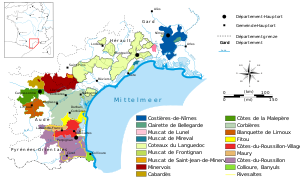Faugères (wine)
The Faugères wine-growing region is located in the north-east of the Saint-Chinian appellation in the Languedoc wine-growing region . The vineyards cover around 2,000 hectares of vineyards in the seven municipalities of Autignac , Cabrerolles , Caussiniojouls , Faugères , Fos , Laurens and Roquessels in the Hérault department . The area lies within the city triangle of Béziers - Bédarieux - Pézenas . The municipality of Faugères gave the area its name. The appellation has had the status of an Appellation d'Origine Contrôlée (AOC for short) for red wine since May 5, 1982 . In 2006, the first white wine with AOC status was marketed. Two wine cooperatives and 41 self- marketers share the market of around 80,000 hectoliters of wine annually .
The vineyards are at an average height of about 250 m above sea level. NN on steep slopes of the Montagne Noire , which geologically in the broader sense is an extension of the Cevennes . The vineyards are often terraced. More than 80% of the soils are assigned to a geological formation with the name "Monts de Faugères" from the geological age of the Mississippian (359.2 to 318.1 mya ). The slate soils of the region, which lie in lines of folds aligned with the Variscan , are among the oldest geological formations in France. The soil is extremely acidic; that is, it has a very low pH .
Since the 1995 vintage , certain top wines have been marketed under the additional name Trois Tours .
Grape varieties
In general, the yields are limited to 50 hectoliters / hectare.
Red wine and rosé wine make up 84% of the cultivation area and consist of the grape varieties Carignan (maximum 40%), Cinsault (maximum 20%), Grenache and / or Lledoner Pelut (at least 20%) Mourvèdre (at least 5%) and Syrah (at least 15%).
White wine is made from the main varieties Grenache Blanc (maximum 70%), Marsanne blanche (maximum 70%), Roussanne (30 to 70%) and Vermentino (maximum 70%, the Vermentino is also called role here).
The secondary varieties Clairette Blanche , Bourboulenc , Macabeo and Carignan Blanc are also permitted. The combined share of the minor varieties must not exceed 10%.
literature
- Jancis Robinson : The Oxford Wine Lexicon . 2nd Edition. Hallwag , Munich 2003, ISBN 3-7742-0914-6 (886 pages, English: The Oxford companion to wine . Translated by Wolfgang Kissel).
- Pierre Galet : Cépages et Vignobles de France . Lavoisier Publishing House, Paris 2004, ISBN 2-7430-0585-8 .
- Benoît France: Grand Atlas des Vignobles de France . Éditions SOLAR publishing house, Paris 2002, ISBN 2-263-03242-8 .
